Yesterday morning as I approached the Eccles Wildlife Education Center at Farmington Bay I noticed some kind of hubbub going on in their parking lot.
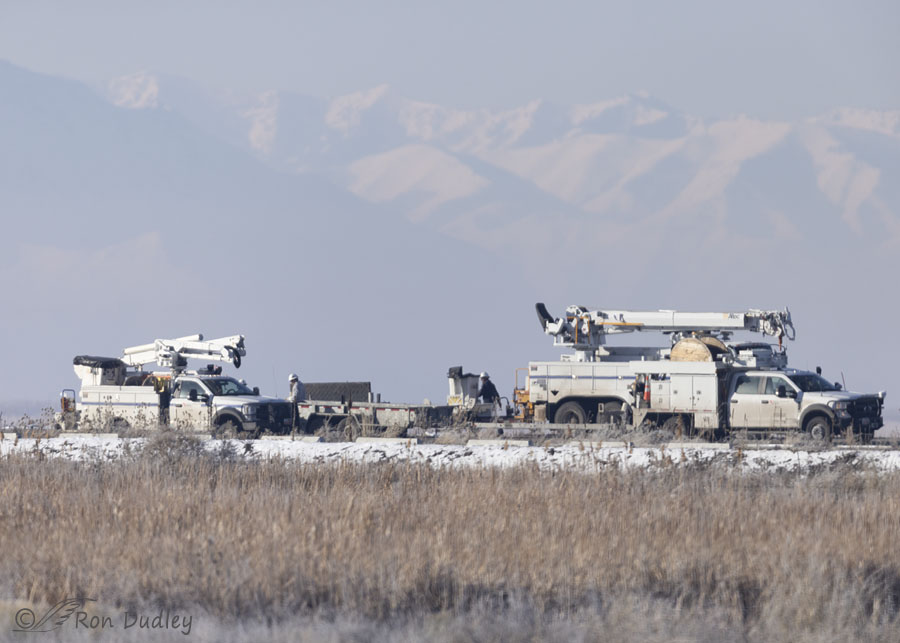
Scoping it with my lens from about a quarter mile away revealed a bunch of heavy construction equipment that I suspected was from Rocky Mountain Power (it was) so I figured they were preparing to do maintenance work on the nearby Great Blue Heron rookery. It isn’t unusual for the nesting platforms to need repair and it was about the right time of year for it – just prior to nesting season and with the ground frozen so the heavy equipment could get to the rookery.
There were a lot of heatwaves in the atmosphere so my photos from so far away were soft, but you get the idea.
I hadn’t intended to turn into the Wildlife Center but after seeing what I did through my lens, nosy old me had to investigate.
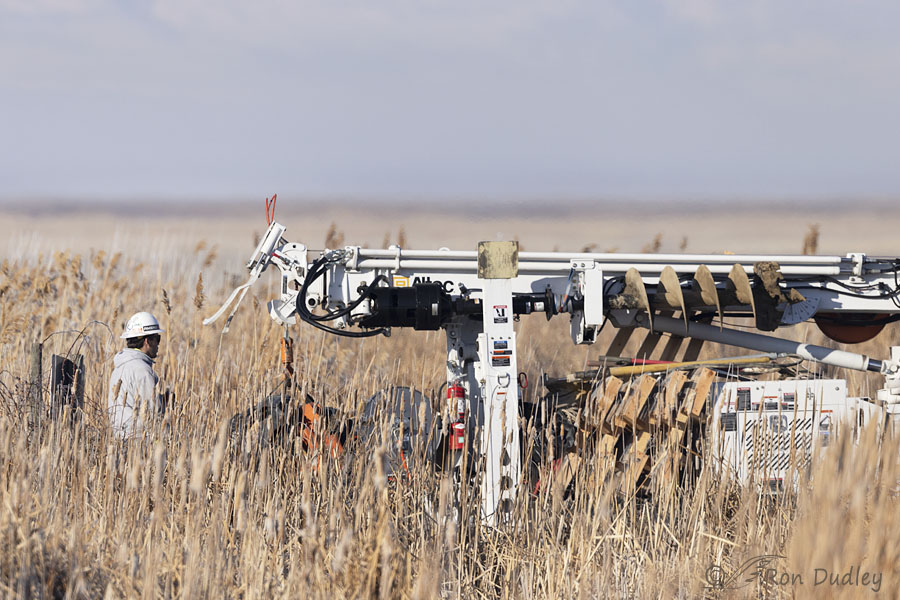
By the time I got to the parking lot there was already a massive utility pole auger slowly working its way through the frozen marsh toward the rookery. The fact that there was an auger involved told me that there was more going on than just platform maintenance. It looked like they were going to erect another pole to support four new nest platforms.
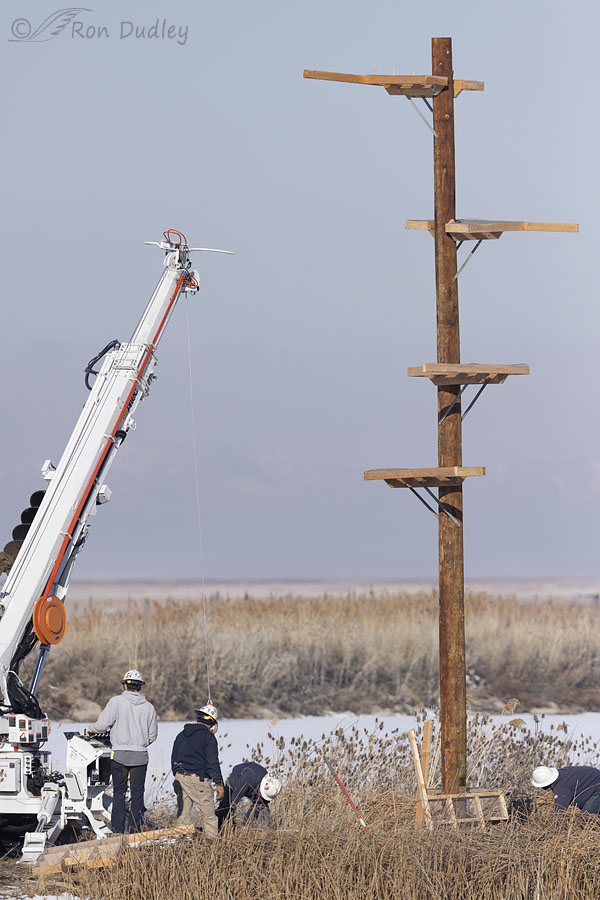
And that’s exactly what they did.
Here we see one of the old poles with attached nesting platforms and a specialized crane for placing a new pole into the hole in the ground that had already been dug by the auger. Leaning against the base of the old pole is one of the four new nesting platforms that will be attached to the new pole when it’s erected.
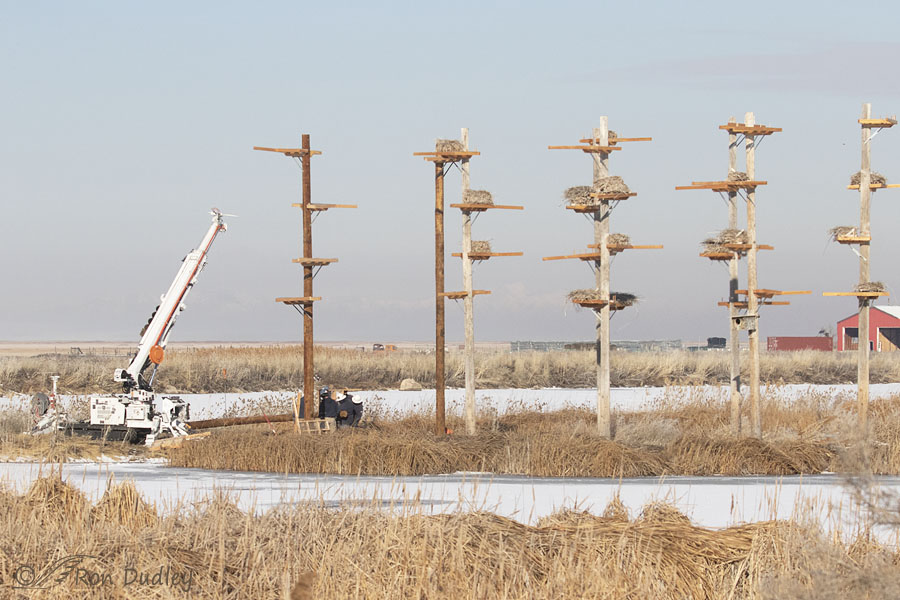
An hour later they had the new pole (on the ground in front of the crane) in position for it to be placed into the hole in the ground.
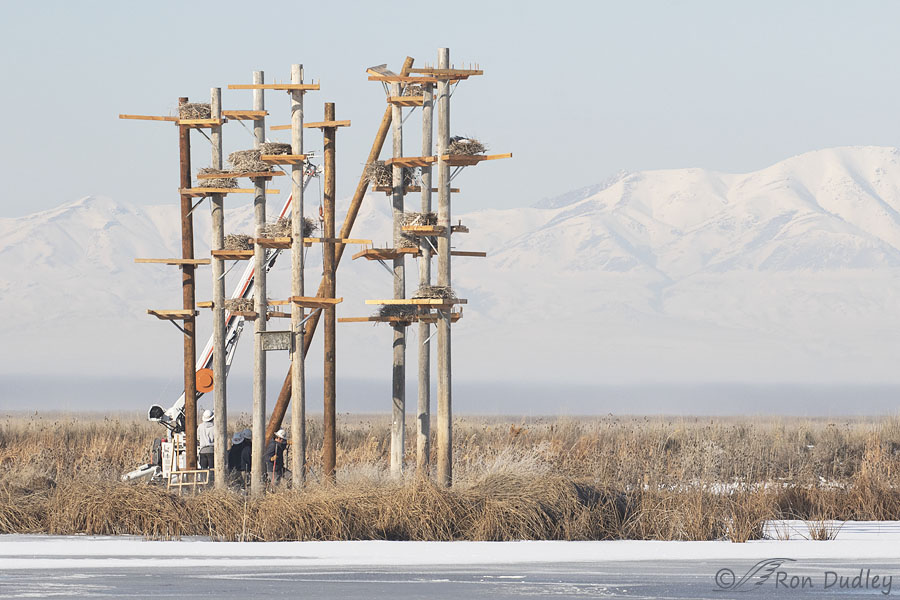
Two minutes later the new pole was about to be dropped into place. This photo was taken from a completely different angle so the rookery appears to be much more compact than it really is.
A bunch of the old nests have apparently blown down since last year’s nesting season and now there’s four new platforms so this spring the herons will be building many new nests, in addition to adding sticks to the remaining old ones. I talked to Dave England, Assistant Manager at Farmington Bay WMA, and he’s palpably excited about all the nest-building activities that visitors will be able to see this spring as the herons build that many massive new nests.
That’s a lot of sticks that have to be delivered.
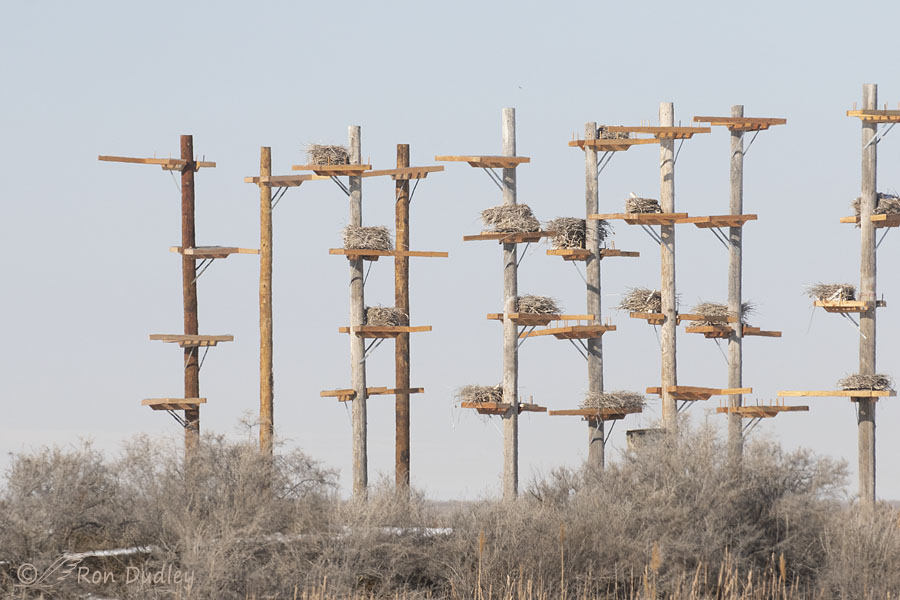
Here we see the new pole, second from left, after it had been dropped into place (I suspect that the pole on the far left is a relatively new pole too). At this point there was only one nesting platform on the new pole but when I talked to the construction crew they told me that they’d be attaching three more platforms.
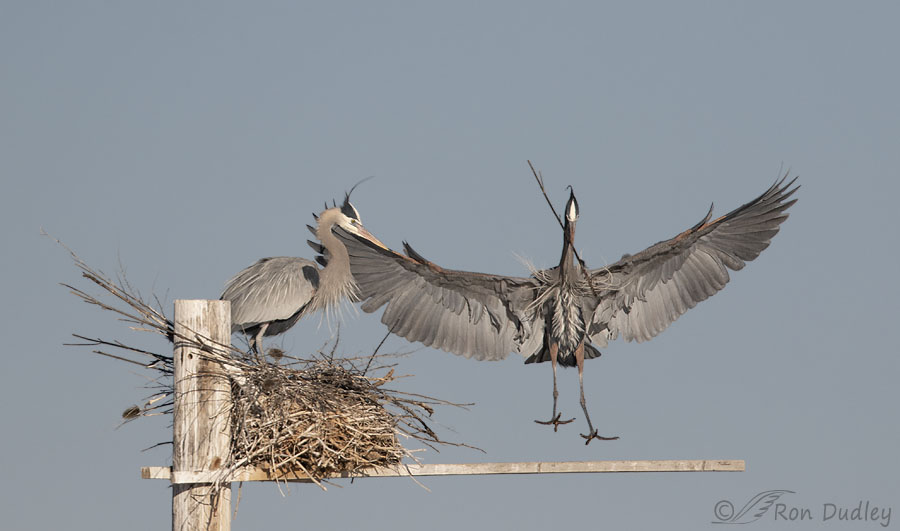
Beginning early this spring there’ll be a lot of opportunities for birders, bird photographers and nature lovers (including droves of school kids who will be visiting the Wildlife Center) to observe some very interesting mating and nest-building behaviors.
It’ll be exciting times at the rookery.
Ron
Note:
I don’t know it for fact but I suspect that Sherry Liquori, Avian/Environmental Program Manager for Rocky Mountain Power, is heavily involved with this project. If so, take a bow Sherry. Sherry is the wife of the late raptor expert Jerry Liguori.


How awesome!
Well that is a first for me too. Never seen a man made rookery . We have large Cotton wood trees in my town and that is where the Blue Heron nest It is funny to see them all nesting in old dead Cotton wood trees so close together.
Trudy, we have big cottonwood trees around here too but I rarely see herons nesting in them.
I should know more about one of my 3 favorite birds! I never realized that these giant birds nested in such close quarters. So excited now for them to get to it! (And for you to document it. ) Even though our regional park has had several resident GBHs, I’ve never seen one of their nests. Now, with all the necessary refurbishing of the human-made ponds going on (a couple were in really bad shape), I’m seeing fewer and fewer waterfowl — even the Canada Geese aren’t plentiful this year. Hopefully, everyone will return once the ponds are sorted.
) Even though our regional park has had several resident GBHs, I’ve never seen one of their nests. Now, with all the necessary refurbishing of the human-made ponds going on (a couple were in really bad shape), I’m seeing fewer and fewer waterfowl — even the Canada Geese aren’t plentiful this year. Hopefully, everyone will return once the ponds are sorted.
Sounds like the crew was having a good time too. A huge thanks to Sherry as well. I hope you get a chance to chat with her about the rookery one of these days.
Marty, most Great Blue Herons are dedicated colony nesters – often in colonies of hundreds of pairs. One documented colony had in excess of 1000 pairs.
I’ve never actually met Sherry Liguori. Several times Jerry told me me “you have to meet Sherry” but it never happened and now Jerry’s gone.
Thanks for posting this. It makes me wonder:
With nary a tree or shrub in sight how far do they have to fly to gather materials for nests?
Without baffles below the nests don’t four-legged predators have easy access to eggs and chicks? Heronries in forests at least have cover to make their nests less obvious.
What does their diet consist of since there are no fish in the GSL? Rodents, snakes, insects?
It appears that there have been several contributors to the Heronry, including your late friend Billy Fenimore.
https://bearriverblogger.com/eagle-scout-power-company-great-blue-herons/
Lyle,
1. They don’t have to go far for nesting materials at all. There’s plenty of sticks from small bushes and there are some trees around. Plus there’s all the sticks from the nests that apparently blew down.
2. The herons would kill, and even eat, most possible predators (snakes, rodents, weasels etc.) that would get to the nests for the eggs and young chicks. If they dared to attempt to climb the poles where they’d be extremely vulnerable to the herons.
3. The refuge is fresh water (stream runoff from the nearby mtns). There’s an abundance of carp and a few small fish species there. Plus, herons eat a lot of things other than fish. In winter after most of the water freezes over they eat a lot of voles. They’re highly skilled vole hunters.
Billy contributed to a lot of things there. Just a few minutes after I took these photos I had a long conversation about Billy with Sherry Sturdevant, a good friend who works as an inhouse artist at the Wildlife Center. You’ll recall that Billy passed away not too long ago.
What an exciting post! A few years ago we got to see an active rookery on Bainbridge Island, WA. There were about 25 nests in the tops of a grove of huge cedars, and it was wonderful! The last construction photo, with all those poles lined up, all that potential on display, makes for a lump in the throat and tears in the eyes. I bet those RMP workers enjoyed that day’s work, too.

And to finish the series with Mom or Dad jumping for joy
” I bet those RMP workers enjoyed that day’s work, too”
In talking to them I had the impression that they did, Carolyn.
Great news for the herons and their fans (of which I am one)! I hope you’ll return later on to grab some photos of the nest-building activities and then the chick-raising .. just wear earplugs!
You can count on it, Chris!
Sweet!
Thanks, Michael.
In such a troubled world this gives me some hope.
Thank You and Take Care,
Kaye
And hope’s a good thing!
Fascinating! Thank you for teaching me yet again this morning Ron.
You’re welcome, Kathleen.
Three cheers ! Hurray for Ms. Liguori ! Hurray for the power company !
Hurray for the herons ! and a 4th hurray for Ron for documenting and
bringing us this GOOD NEWS for something to celebrate in this world
today……..
Thank you, Kris.
What an interesting post Ron, and so neat that they do that for the Herons where there is not a tree in sight. Like Terri-Ann we have a couple large areas of natural rookeries here in Prescott. In our Willow Lake riparian woods area we have a large contingent of Herons and Cormorants who nest high up in the tops of the Cottonwood trees. During the mating and birthing season the noise in these woods is loud. Once two women were leaving the area and urged me not to go in because there was probably a mountain lion there. I assured them that it was the noise of the birds overhead and coaxed them back in and showed them the aerial show overhead.
Thanks for posting this very interesting information complete with your always outstanding photos.
Thanks, Everett. Interesting and amusing story about the ladies and the supposed mountain lion.
Cool! Down towards Townsend they’re errected and(sometimes) moved Great Blue nests from near by power poles to save everyone headaches. Seems the rural electric has done similar things around the state.
Judy, around here they do the same thing with Osprey nests on poles.
They also do that for the Osprey here…….
Ron – I spent lots of time at a Heron rookery here in RI last spring and summer. The nesting sites are not as sturdy as these, and I’m amazed at the small size of the nests for such large birds! Thanks for this hopeful look ahead to warmer weather and more Heron chicks.
I’m glad you enjoyed it, Noel. Thanks.
Fascinating! I’ve never seen a manmade rookery like this! It’s perfect timing because all this week I’m taking students to see the rookery of Great Blue Herons (already on nests), Great Egrets, and Double-crested Cormorants at their lakeside rookery in a local eucalyptus grove here on Central Coast of California. If Sherry helped spearhead this project, then, yes, kudos to her, too. I always admired her husband’s impressive raptor work, and she’s making a major contribution to the avian world, too.
Nanci
She sure is, Nanci. And she’s been doing it for a very long time.
Like Nanci, I have never seen a manmade heron or egret rookery. There were many of them in the Atchafalaya basin of Louisiana and they were loud. There is a local one on some UW-Madison property that is relatively easy to observe.
Pam, I wish we had a natural one but in that particular area trees that are appealing to nesting herons are few and far between.
Ron, I really enjoyed your post today. As the Blue Herons show up they are going to think they are in Hog Heaven!! I also wanted to comment on the work the Power Company is doing. I watch a lot of bird sites where the local Power company has helped out Like bring staff up to do banding, returning a young bird back to it’s nest and working to make electric lines safer for our birds. Not all business would do something like that!
Jo Ann, I’m sure Sherry Liguori has had a lot of positive influence on RMP.
Wonderful project! In East Texas one day on a forest trail on a horse where tall pine trees grow, I looked up and saw a rookery of Great Blue Herons (about 10 nests) in a small area, and it was beautiful! But I also realized they were agitated and I should leave them in peace so I never went back again.
Lucky you, Terri. I’ve never experienced a rookery in natural vegetation.